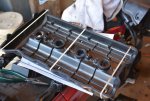I am retired mechanic shop owner who does my own wrenching on all my vehicles including my 2002 Concours.
HEADS UP: In reviewing the COG Tech Pages for the C10 Valve Adjustment; I would warn against the 2003 Update advice of using the Cam Lobes Up model for adjusting valves. Here's my reason (verify yourself): Adjusting your valves the factory manual recommended TDC way may get different results than the Lobes Up valve adjustment. I just figured this is true for my 2002 ZG1000. Maybe it is different for other models?
For the record, my tunes ups have my Connie purring like a kitten; and producing full smooth power when I pass cars. I use sea foam fuel cleaner at least twice per year to keep my carbs free of varnish. I would recommend the Tech overseeing COG's Valve Adjustment info. include my "Heads Up" in the official valve adjustment section.
I now believe the COG Tech "Update Oct 2003" may produce unintended lesser tuned Connies: The specific text of that update says: "Starting at cylinder number 1, I hit the starter until the intake cam lobe is anywhere above horizontal and thereby leaving the valves fully closed. Just a few quick taps or two on the starter button will usually do it. Check and adjust both #1 intake valves as necessary. Then, move on to the intakes on cylinder number 2. It's just that easy. Once the intakes are done, do the exhaust. Don't forget to change to the other feeler gauge."s
Yes that is easier, but it get different results as compared to the factory recommended TDC way on my 2002 Concours (for me). Food for Discussion? I Hope So!
HEADS UP: In reviewing the COG Tech Pages for the C10 Valve Adjustment; I would warn against the 2003 Update advice of using the Cam Lobes Up model for adjusting valves. Here's my reason (verify yourself): Adjusting your valves the factory manual recommended TDC way may get different results than the Lobes Up valve adjustment. I just figured this is true for my 2002 ZG1000. Maybe it is different for other models?
For the record, my tunes ups have my Connie purring like a kitten; and producing full smooth power when I pass cars. I use sea foam fuel cleaner at least twice per year to keep my carbs free of varnish. I would recommend the Tech overseeing COG's Valve Adjustment info. include my "Heads Up" in the official valve adjustment section.
I now believe the COG Tech "Update Oct 2003" may produce unintended lesser tuned Connies: The specific text of that update says: "Starting at cylinder number 1, I hit the starter until the intake cam lobe is anywhere above horizontal and thereby leaving the valves fully closed. Just a few quick taps or two on the starter button will usually do it. Check and adjust both #1 intake valves as necessary. Then, move on to the intakes on cylinder number 2. It's just that easy. Once the intakes are done, do the exhaust. Don't forget to change to the other feeler gauge."s
Yes that is easier, but it get different results as compared to the factory recommended TDC way on my 2002 Concours (for me). Food for Discussion? I Hope So!


